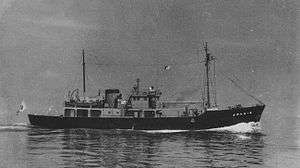Kaiyō No.1-class oceanographic research ship
 Kaiyō No. 1 in 1939 | |
| Class overview | |
|---|---|
| Name: | 200-ton oceanographic research ship |
| Builders: | Mitsubishi Heavy Industries, Shimonoseki shipyard |
| Operators: | |
| Preceded by: | Tenkai No. 1 as IJN |
| Succeeded by: | JCG Kaiyō as JMSA |
| Built: | 1939–1943 |
| In commission: | 1938–1964 |
| Planned: | 6 |
| Completed: | 6 |
| Lost: | 5 |
| Retired: | 1 |
| General characteristics | |
| Type: | Oceanographic research ship |
| Displacement: | |
| Length: | 37.0 m (121 ft 5 in) overall [1] |
| Beam: | 6.8 m (22 ft 4 in) [1] |
| Draught: | 2.3 m (7 ft 7 in) [2] |
| Draft: | 3.3 m (10 ft 10 in) [1] |
| Propulsion: | |
| Speed: | 11 knots (13 mph; 20 km/h) [2] |
| Range: | 7,000 nmi (13,000 km) at 10 kn (12 mph; 19 km/h)[4] |
| Complement: | 44 in 1944[5] |
| Armament: |
|
The Kaiyō No. 1-class oceanographic research ship (第一海洋型海洋観測船, Daiichi Kaiyō-gata Kaiyō-kansokusen) was a class of oceanographic research ship/weather ship of the Imperial Japanese Navy (IJN), serving during World War II. The IJN official designation was 200-ton oceanographic research ship (二〇〇瓲海洋観測船, 200-ton Kaiyō-kansokusen).
Construction
In 1938, the IJN wanted to investigate the weather and ocean current in a potential future battlefield. Kaiyō No. 1-class ships were built for the purpose. The IJN made Hokkaido Fisheries Research Institute San'yō Maru a sample for the Kaiyō No. 1. All ships were deployed in the Hydrographic Department, and they were direct controlled from the Naval Ministry. Therefore, being government ships, they raised civil ensign, not the naval ensign. The crew were civil servants except for several warrant officers.
All sister ships were built by Mitsubishi Heavy Industries at Shimonoseki shipyard.
Ships in classes
| Ship | Laid down | Launched | Completed | Fate |
| Kaiyō No. 1 (第一海洋, Daiichi Kaiyō) | 1 March 1939 | 1 July 1939 | 9 October 1939 | Sunk by air raid off Derawan Island 02°18′N 118°15′E / 2.300°N 118.250°E[6] on 19 October 1944. |
| Kaiyō No. 2 (第二海洋, Daini Kaiyō) | 1 July 1939 | 4 October 1939 | 23 December 1939 | Sunk by Hr. Ms. Zwaardvisch off Rembang 06°30′S 111°35′E / 6.500°S 111.583°E[7] on 15 October 1944. |
| Kaiyō No. 3 (第三海洋, Daisan Kaiyō) | 3 March 1941 | 22 October 1941 | 17 June 1942 | Missing in action in late 1944; removed from naval ship list on 29 October 1944. |
| Kaiyō No. 4 (第四海洋, Daiyon Kaiyō) | 23 May 1941 | 20 January 1942 | 17 July 1942 | Survived war at Uraga;[8] transferred to Ministry of Transport on 29 November 1945; transferred to Maritime Safety Agency on 1 May 1948 (hull number HG-01, later HM-01); renamed Kaiyō Maru No. 4 (第四海洋丸, Daiyon Kaiyō Maru) on 20 October 1949; renamed Kaiyō (海洋) on 15 December 1956; retired on 26 March 1964. |
| Kaiyō No. 5 (第五海洋, Daigo Kaiyō) | 6 April 1942 | 12 November 1942 | 28 February 1943 | Survived war at Kasaoka;[8] transferred to Ministry of Transport on 29 November 1945; transferred to Maritime Safety Agency on 1 May 1948 (hull number HG-02, later HM-02); renamed Kaiyō Maru No. 5 (第五海洋丸, Daigo Kaiyō Maru) on 20 October 1949; sunk by jets of water and tephra[9] from the eruption of Myōjin-shō on 24 September 1952; struck on 27 April 1953. |
| Kaiyō No. 6 (第六海洋, Dairoku Kaiyō) | 6 April 1942 | 12 December 1942 | 31 March 1943 | Sunk by USS Gabilan off Muroto 32°50′N 134°21′E / 32.833°N 134.350°E on 31 October 1944. |
Photos
-

Kaiyō No. 2
-

Kaiyō No. 2 (bird's‐eye view)
-

Kaiyō No. 6 in 1943
-

JCG Kaiyō Maru No. 4 (ex-Kaiyō No. 4) in 1950s
-

JCG Kaiyō Maru No. 5 (ex-Kaiyō No. 5) in 1950s
-

JCG Kaiyō (ex-Kaiyō No. 4)
Footnotes
- 1 2 3 4 5 6 Monthly Ships of the World (2003), p. 52
- 1 2 Jirō Kimata (1999), p. 338–339
- 1 2 Jirō Kimata (1999), p. 331–333
- ↑ Shizuo Fukui (1994), second separate volume p. 925
- ↑ JACAR C08030773600, p. 10–13
- ↑ JACAR C08030773600, p. 4
- ↑ JACAR C08030773600, p. 26
- 1 2 JACAR C08011043700, p. 2
- ↑ "bayonnaise Rocks Volcano" at volcanodiscovery.com (retrieved 10 October 2012)
Bibliography
- Monthly Ships of the World No.613, Special issue "All ships of Japan Coast Guard 1948–2003", "Kaijinsha"., (Japan), July 2003
- Jirō Kimata, Introductory book of the Japanese small vessels, Kōjinsha (Japan), December 1999
- 30 year History of Japan Maritime Safety Agency, Policy and Legal Affairs Division-Japan Maritime Safety Agency (JMSA), May 1979
- 75 year History of Mitsubishi Heavy Industries-Shimonoseki shipyard, Mitsubishi Heavy Industries-Shimonoseki shipyard, 1964
- Shizuo Fukui, FUKUI SHIZUO COLLECTION "Japanese Naval Vessels 1869–1945", KK Bestsellers (Japan), December 1994
- "Japan Center for Asian Historical Records (JACAR)"., National Archives of Japan
- Reference code: C08011043700, Ships and boats list
- Reference code: C08030773600, Data relevant to Daiichi-Kaiyo-maru (No.1) and Daini-Kaiyo-maru (No.2), October 1944